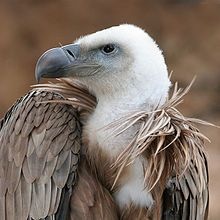Vulture is the name given to two groups of convergently evolved, usually scavenging birds of prey: the New World vultures, including the Californian and Andean condors; and the Old World vultures, including the birds that are seen scavenging on carcasses of dead animals on African plains. Research has shown that some traditional Old World vultures (including the bearded vulture) are not closely related to the others, which is why the vultures are to be subdivided into three taxa rather than two. New World vultures are found in North and South America; Old World vultures are found in Europe, Africa and Asia, meaning that between the two groups, vultures are found on every continent except Australia and Antarctica.
A particular characteristic of many vultures is a bald head, devoid of normal feathers. Although, it has been historically believed to help keep the head clean when feeding, research has shown that the bare skin may play an important role in thermoregulation.[1]Vultures have been observed to hunch their bodies and tuck in their heads in the cold, and open their wings and stretch their necks in the heat.
A group of vultures is called a wake, committee, venue, kettle, or volt. The term kettle refers to vultures in flight, while committee,volt, and venue refer to vultures resting in trees. Wake is reserved for a group of vultures that are feeding.[2][3] The word Geier(taken from the German language) does not have a precise meaning in ornithology; it is occasionally used to refer to a vulture in English, as in some poetry.



